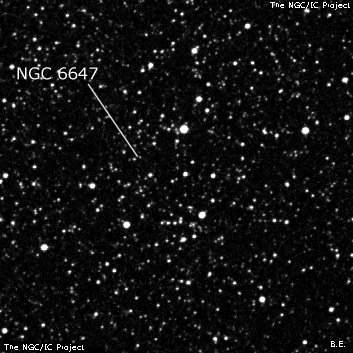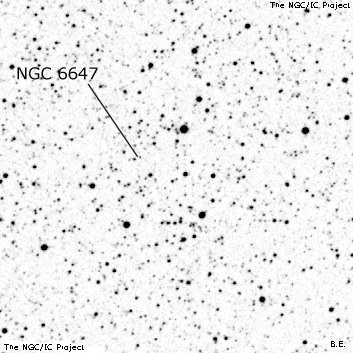NGC/IC Project Restoration Effort
(This is a very very beta version)
NGC6647


Basic Information
Location and Magnitude
Right Ascension: 18:32:49.0
Declination: -17:13:42
Constellation: SGR
Visual Magnitude: 8.0
Historic Information
Discoverer: Herschel W.
Year of discovery: 1784
Discovery aperture: 18.7
Observational
Summary description: Cl, L, Ri, lC, st vS
Sub-type: OCL
Corwin's Notes
=====
NGC 6647 = H VIII 14. WH found this on 18 June 1784; he called it "A Cl of
sc pL sts" in his PT paper. The sweep has it as "A cl of sc stars filling the
field; not rich and the stars less than those in the foregoing [M 25 =
IC 4725, which see]". JH also claims to have seen it; his position --
somewhat east of his father's and marked "+-" in RA -- is adopted in GC and
NGC. Curiously, he has it as "A very loose parcel of v small stars, hardly
noticeable as a cluster," not in very good agreement with his father's
description. Further, in the GC, JH has "Cl, L, Ri, lC, sts vS." How he got
that out of his and his father's observations is a mystery to me. Perhaps he
penned the description in haste, or mistakenly copied it from another object.
There is nothing obvious at either position. WH's original position is about
8 arcmin west-northwest of his son's. There is no evidence in the sweep that
WH's position is incorrect; reducing it with respect to another star
(HD 170680) in the sweep gives the same position as the star that WH uses in
his published list (43 Sgr). The position for M 25 that WH finds is about 25
seconds of time west of the modern positions, but that cluster is much larger
than his field, so he would have had some trouble estimating the center.
Just four arcmin northeast of WH's position is a group, about four arcmin
across, of a couple of dozen stars. The brightest is around 12th magnitude.
These may be some the stars that WH took to be a cluster, so I had earlier
listed it as a possibility for the NGC object.
However, having finally (in early February 2016) seen the sweep with it's
fuller description, it's clear that WH's cluster is much larger, on the order
of the field size, 15 arcminutes. The only DSS image that offers a fairly
clean view of the field is the DSS1 blue image. Mentally filtering out the
myriads of background stars leaves a sprinkling of brighter stars that more or
less match WH's description. I make this apparent "cluster" approximately 13
by 10 arcminutes, and put the center almost exactly at WH's position. But
seeing it in the DSS image leaves me unimpressed; I'd be surprised to find a
real cluster here.
Curious to know if this larger grouping persists at the eyepiece, I checked
Steve Gottlieb's visual observation from July 2013 with a 24-inch telescope at
125X; his field was 50 arcminutes across. Steve sees only half a dozen 10th
magnitude stars centered a few arcminutes northeast of WH's position. These
may be the same clump that I picked out earlier, and are included in the
larger "cluster" that I think I see on the DSS. Like me -- and JH -- Steve is
underwhelmed.
Digging into the literature, I found a reference to the cluster in one of
Walter Scott Houston's Sky and Telescope columns (in the January 1976 issue),
asking for information on this cluster and other of the RNGC "nonexistent"
clusters.
This led me to Archinal and Hynes who suggested the star cloud 1.2 minutes
west and five arcminutes south of WH's position. Tracing this back to Brent's
Webb Society Monograph, I see that he credits one of my early lists of (R)NGC
corrections based on my ESGC sweeps for galaxies -- I was indeed checking
every NGC number in the south-equatorial zone. I now think this star cloud is
very unlikely as there no hint of an error in WH's observation that would push
his position back this far to the west. And WH describes a scattering of
brighter stars, not the fainter ones comprising the cloud.
The professional catalogues are no help, either. The Alter et al (1970)
catalogue has only a token entry for the cluster at the same position as
Archinal and Hynes give (which is probably from Alter et al), though does give
an integrated magnitude of 8.0. Lynga (1987) repeats this, but makes the
declination just an arcminute to the north, perhaps a typo.
Finally, working with the Archinal and Hynes position as input, Kharchenko et
al. (A&A 558, 53, 2013) used PPMXL and 2MASS to find a "remnant cluster" here.
Their algorithms put the remnant at 5.25 kpc away with a barely significant
proper motion, and give it 136 stars over a diameter of thirteen arcminutes,
with 43 in the central 7.2 arcminutes, and just three in the 1.5 arcminute
core. They also note "Poorly seen in the rich background." My feeling is
that they have applied their computer pipeline to a random patch of the Milky
Way. This, by the way, is cluster number 2939 in their catalogue. My overall
assessment of this "remnant cluster" -- "Underwhelmed."
Whatever the case, the clump of stars that I believe to be WH's object does
not match the NGC description, though it does more or less fit what WH himself
recorded. So, I am going to take it, with some trepidation, as NGC 6647.
Steve's Notes
=====
NGC 6647
24" (7/7/13): patchy Milky Way star cloud at 125x (50' field). Unimpressive and does not stand out from the surrounding region except the position is centered on a scattered group of a half-dozen mag 10-11 stars, spread out over 7' in a SE to NW orientation. Located ~23' SSE of the rich open cluster NGC 6645.



